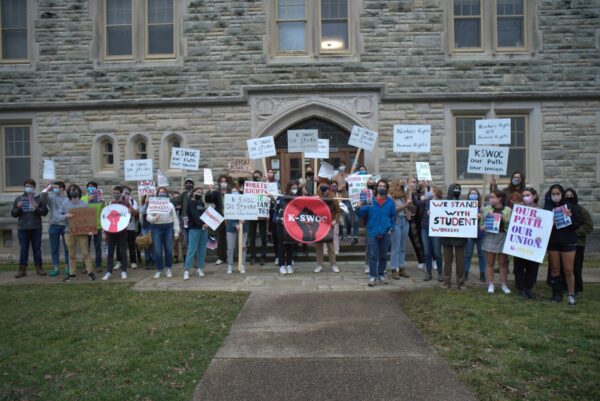
GAMBIER, Ohio—At least 140 student workers at Kenyon College in Ohio joined a walkout on Apr. 27, the second day of what the Kenyon Student Worker Organizing Committee (K-SWOC/UE) union believes is the first strike ever for union recognition by undergraduate workers at a U.S. college.
The strike began Apr. 26, after the college administration rejected the union’s offer to hold a “community election” — a secret-ballot vote independently overseen, but not part of the National Labor Relations Board process — if the administration would agree to recognize it and begin contract talks if K-SWOC won a majority of the votes. The first to walk out, says K-SWOC spokesperson Sally Smith, were about 30 “apprentice teachers,” juniors and seniors who help teach language and literature classes, and get paid $10.03 an hour. More workers joined the next day.
K-SWOC, formed in April 2020, now has more than 300 members, Smith says. Affiliated with the United Electrical, Radio and Machine Workers of America, whose Local 712 represents Kenyon’s skilled maintenance workers, it hopes to become the nation’s first undergraduate multi-shop student labor union. It says it represents approximately 60% of student workers at the college and 56% of apprentice teachers.
“The latest action from the college is part of a larger trend of minimizing and undercompensating the work and value we add to this campus,” junior Ariella Kissin, an apprentice teacher in Russian, said in a statement released by K-SWOC Apr. 26. “A union allows us to speak with our own voice as to what we want to see regarding job security, wages, compensation, and equity.”
“It’s really weird to think about how much people are paying to go here and how little students are paid,” Smith says. Tuition, room, and board now cost almost $71,000 a year, and are scheduled to go up to about $74,000.
The college press office said it could not comment because its media contact person was on bereavement leave.
In rejecting the union’s request to be recognized by card check last December, though, the administration contended that having student jobs unionized would interfere with their educational purpose. It also claimed that recognizing the union would bring an outside party into campus governance and disenfranchise future student workers who did not want to join it.
Kenyon College, founded in 1824, is a small private liberal-arts school located in a rural area northeast of Columbus. It might be best known as the publisher of the Kenyon Review literary magazine.

Interns at Kenyon Review are among the workers K-SWOC represents, as are lifeguards at the swimming pool and workers at the library, film center, farm, and greenhouse. The union staged a one-day strike on March 16 in which about 140 people walked out, says Smith.
Unions of student workers are on precarious legal ground, however. Whether the NLRB recognizes their right to organize has depended on which party controls the board’s majority. Under President George W. Bush, it ruled that graduate assistants at private universities were primarily students, not employees, and therefore could not have a union. The Obama-era NLRB reversed that in August 2016, holding that graduate assistants at Columbia University in New York were employees with the right to have a union.
The Trump administration’s majority on the board put a chill on student unions’ seeking its support against universities resisting them. When a union recognized in 2016 as representing dining-hall workers at Grinnell College in Iowa tried to expand to other student workers in 2018, says Smith, it withdrew its bid for recognition to the NLRB, out of fear that the board would reverse the Columbia decision.
The Trump NLRB never got a case to reverse the Columbia precedent, but in 2019, it proposed a rule that all graduate and undergraduate students at private institutions who get wages or financial aid for any work done in connection with their studies are not employees, because their work is “primarily educational.” The Biden NLRB withdrew that proposal on March 9.
The board still has a 3-1 majority of Trump appointees, although President Joseph Biden replaced its general counsel the day he took office in January.
The COVID-19 pandemic was “a real catalyst” for organizing a college-wide union, says Smith. When the college closed last spring, student workers were unsure if they would get paid for the rest of the semester. They eventually were, but it crystallized sentiment towards “we should have a contract. We should have institutional power.”
“In my time at Kenyon, the administration has demonstrated that they do not take student input into account and that they are willing to bend labor law when they see fit,” sophomore Owen Hevly, student manager at the Brown Family Environmental Center, the college’s 500-acre nature preserve, said in a statement released by K-SWOC Apr. 27. “The only way to end these unfair practices is to give workers a seat at the table through a recognized union.”


